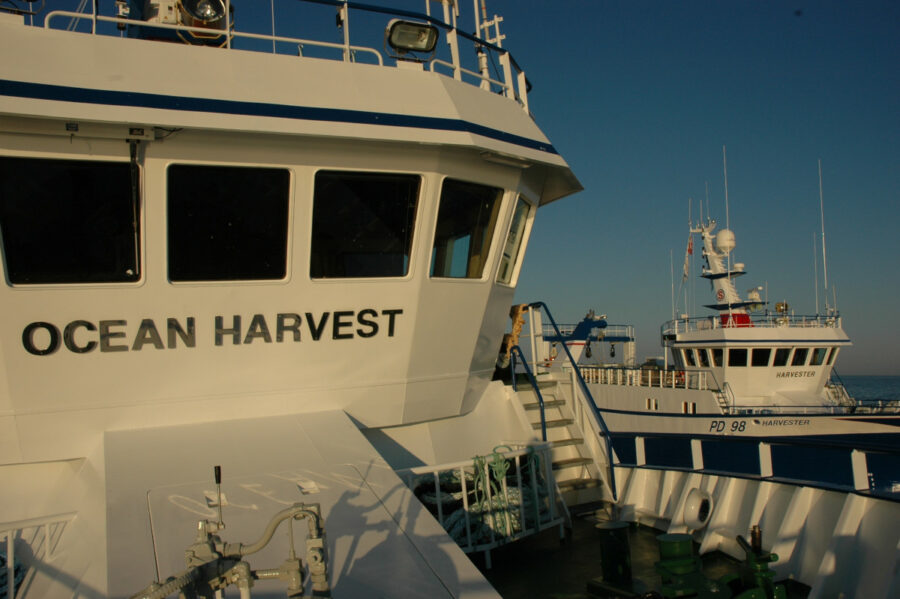David Linkie looks back 12 years to the maiden pair-seining trip of the innovative sisterships Harvester PD 98 and Ocean Harvest PD 198, built by Karstensens shipyard, which marked a significant milestone for the Scottish whitefish fleet
The intensive work by the skippers – Brian Stephen on Ocean Harvest and his brother John Stephen on Harvester – and crews, of rigging out the new vessels, running trials and taking on stores at Skagen, was matched by the efforts of staff at the vessels’ agent Peterhead Fishermen Ltd.
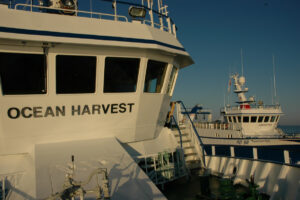
Harvester moves into position alongside Ocean Harvest to buckle up.
They completed the raft of paperwork associated with the arrival of two new boats, faxed over fishing licences and secured the vital approval to fish in the Norwegian sector – which reduced steaming time before the boats could begin fishing from 30-plus hours to just 12.
This concerted team effort achieved the desired result of enabling the pair-team to leave Skagen shortly before Thursday midnight, 3 July, 2008, with everything in place for their first trip.
Some 14 hours later, Ocean Harvest’s crew shot the hopper pair-seine off the drum, before skipper John Stephen eased Harvester into position, ready for the waiting crew to buckle up the sweeps for the first time on the Lang Shall.
Three hours earlier, Harvester and Ocean Harvest had passed the German-registered pair-team of Kristen and Victoria towing in an area where they reported taking reasonable catches of large coley – albeit on hard bottom, which the skippers were counteracting by working wire next to the net rather than combination rope.
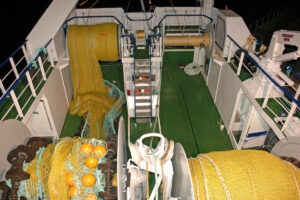
Gear-handling arrangements on the shelterdeck of Ocean Harvest.Gear-handling arrangements on the shelterdeck of Ocean Harvest.
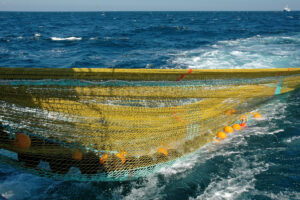
Ocean Harvest shoots away the Jackson Trawl hopper pair-seine for the first time.
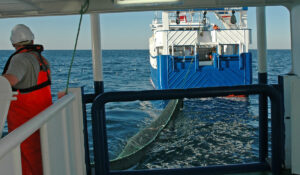
Passing fish over to Harvester.
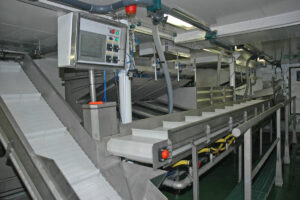
Ocean Harvest’s integrated fish selection and washing system.
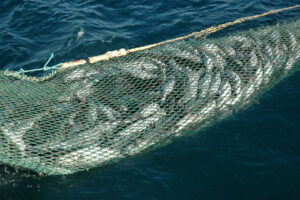
Taking a haul of coley…
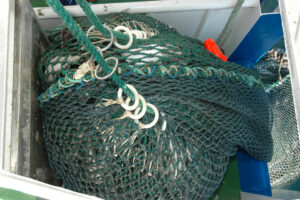
… aboard Ocean Harvest.
Although promising marks were continually appearing on Ocean Harvest’s Skipper GDF201 sounder, skippers John and Brian Stephen continued to steam towards their originally selected spot, rather than shooting away for the first time on poor bottom.
Although the skippers and crews were taking their first steps towards familiarising themselves with the very different working arrangements on the new boats, the net was shot away cleanly before the sweeps were passed across. The boats then pulled apart to run off three coils of 50mm-diameter Malleta seine-net rope, followed by 200 fathoms of 24mm-diameter wire and 120 fathoms of 20mm Brunton Shaw TrawlMaster wire, in 67 fathoms.
Ocean Harvest was using a Jackson Trawls high-standing hopper pair-seine with 580 x 8in meshes in the fishing circle, rigged on 150ft of ground gear comprising 16in/18in-diameter hoppers. The hoppers were separated by between 20 and 30 tightly packed ¾-1¼in thick 120mm-diameter canvas rubber discs rigged on chain – an arrangement with sufficient flexibility to bend when being wound onto the drum, so saving space. Constructed throughout from 3.1mm Sapphire twine to reduce drag and fuel consumption and fitted with 5mm double Sapphire codends, the hopper net was worked with 30-fathom sweeps, with the lower one made from 16mm mid-link chain, while 20mm-diameter wire was used for the top sweep.
A similar sweep arrangement was used with the discer net, apart from the substitution of 22mm wire covered with 60mm rubbers for the lower chain sweep.
Keeping station 0.25 miles off her neighbour’s port side, Ocean Harvest was towing at 3.4 knots using 57% propeller pitch and 980rpm. Even allowing for the fact that the new gear was at its lightest, the skippers were happy with the fuel meter showing an hourly consumption of just 54 litres per hour.
Harvester and Ocean Harvest were powered by Caterpillar 3508B flexible-mounted engines that developed 670kW @ 1,200rpm and were coupled to Hundested 8.5:1 reduction gearboxes to turn Hundested 2,800mm-diameter four-bladed CP propellers in matching steering nozzles. When steaming west through the Skagerrak at 10.4 knots, Ocean Harvest used 115 litres an hour, running at 1,160rpm and 83% propeller pitch.
Ocean Harvest’s main hydraulic systems were operated by three Denison pumps fitted to gearbox PTOs. In addition, two 11kW power packs drove the pilot and spooling systems, a 20kW power pack operated the landing crane and auxiliary hydraulics, and the towing pump was driven by a 55kW unit.

Releasing a bag of cod.

Boxes steadily accumulated in the fishroom during the first 24 hours of successful fishing.
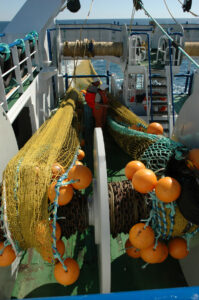
The hopper net is shot away off the starboard drum.
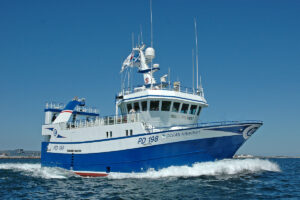
Ocean Harvest…
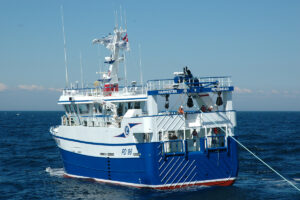
… and Harvester were delivered simultaneously by Karstensens after being built to a completely new design concept.

The Scanmar TrawlEye headline sounder…

… displaying invaluable information on the opening of the net, symmetry, ground contact, and the level of fish passing under the sensor into the net.
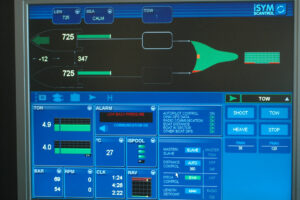
The information display from the Scantrol Ispool auto pair-seine system.
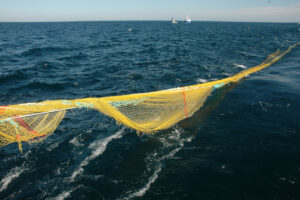
Mending needles (and mugs of tea) to the fore as a badly torn net surfaces after a two-hour tow…

… which still yielded six lifts of big coley.
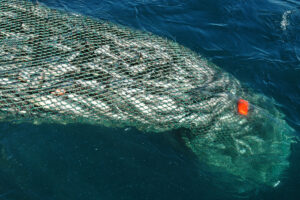
Drying the bag up.
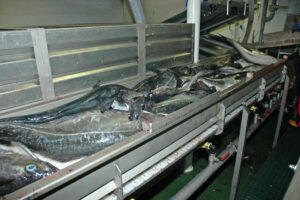
The first fish on Ocean Harvest’s selection/gutting conveyor.
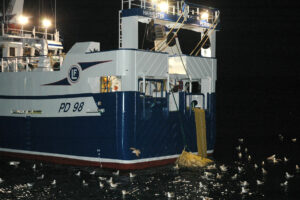
Harvester preparing to take…

… the first of three lifts of green onboard from the pair’s second haul.
In constant communication, Brian and John Stephen quickly got to grips with setting up and confirming the operation and function of the Scantrol radio pair-link system. The Scanmar TrawlEye sensor showed a headline opening of 5.4 fathoms, in addition to indicating a reasonable density of fish entering the net, and a peaky bottom. This was quickly confirmed by the fact that the gear was snagging regularly, before coming clear again. The skippers attributed the catchy nature of the first tow to a clay bottom, with the hoppers thought to be digging into the sizeable peaks.
Two hours into the first tow into the westward as the bottom shoaled up to 54 fathoms, the concerns of skippers fishing in an unfamiliar area became a reality as the gear came fast. On heaving back, the weight finally came off the sweeps. As the wings of the net started to be wound onto the split drums, the first signs of a badly torn net emerged astern of Ocean Harvest, at the same time as a healthy-looking codend floated up.
The first priority was to take the fish aboard, while skipper and crew contemplated the hours of net-mending that lay ahead. The damage was thought to have arisen as a result of the mouth of the net somersaulting after the hoppers dug in and rebounded into the headline, with the resulting strain tearing along ropeages behind the belly of the pair-seine to create some long ragged tongues of torn netting. Taking three 35 to 40-box lifts of large blackjacks – the first fish released onto Ocean Harvest’s hopper – helped to keep the crew in buoyant mood through the long spell of mending.
Arrangements aft, where the codend Gilson was located on the shelterdeck just forward of the central hopper to give almost perpendicular leads, proved more than capable of lifting large bags of fish through the stern gantry, before the codline was quickly retied and lowered back into the water in preparation for another lift.
By the time the third lift was released, Harvester was in position astern with the crew waiting to throw a line across, before the bag was hauled across the short gap and the first of another three lifts was soon being taken aboard.
Since the hopper pair-seine would be out of action the next 12 hours at least, Brian and John Stephen decided to steam west towards shallower ground for an hour before the comparatively lighter discer net was shot in 39 fathoms.
As the pair-team settled into their second tow late on the Friday evening on cleaner-looking bottom, the boats were towing 0.32 miles apart after shooting 725 fathoms of warp. This followed the skippers’ usual practice of closing up to 0.15 miles apart when towing the hopper pair-seine with wire only on hard ground, and to 0.35 miles on cleaner bottom, when the tendency is to work more warp – with a key factor being the weight of the heavy combination rope next to the net to ensure maximum ground contact.
With 250ft of 12in/14in-diameter discs and 60mm-diameter canvas rubbers rigged on 22mm-diameter wire down the wings and chain in the middle bosom section, Ocean Harvest’s clean-ground discer net, which had 750 x 6.25in meshes in the round, was shown by the Scanmar ScanMate 6 net-monitoring system to give an average headline height of 3.7 fathoms.
While two crewmen remained on deck to get to grips with mending the torn hopper net, the other four were eager to try out Ocean Harvest’s fish-handling system. This worked well from the off, with the crew more than happy with the standard at which gutted fish were coming out of the integral washers, before being delivered by secondary conveyors to holding hoppers in the fishroom.
Following a routine five-hour tow, during which both the boat- and net-mounted sounders showed some encouraging signs of fish on the bottom and passing under the headline, the pair-team closed together again before the starboard sweeps were passed over, as Harvester’s crew prepared to haul the gear aboard for the first time.
As the codend entered the periphery of Harvester’s floodlights, her crew were soon shouting over to report a good haul of green. After Harvester had taken three lifts, the final two were passed over to Ocean Harvest. This demonstrated the effectiveness of arrangements for bagging and passing fish over aft, with the process being quickly completed by crews new to this method of working.
Two hours after taking aboard 220 boxes of green, the boats were soon towing north again at 2.9 knots in 44 fathoms, with the fuel meter indicating 59 litres for 1,000rpm and 55% propeller pitch. Brian Stephen commented that this economical level of fuel consumption was virtually no more than the previous Ocean Harvest averaged when towing considerably smaller and lighter gear. When the fuel used by the Cummins auxiliary engine and the higher consumption rate of the main engine when steaming or towing into heavy weather were added to the equation, early indications were that the new boats would use around 70-75 litres an hour (1,680-1,800 litres per day) when averaged across a full trip – a figure well within the original projections of 2,000 litres per 24 hours. This clearly showed the running expense benefits associated with purpose-built new boats incorporating the latest thinking in both hull design and machinery technology.
After the third haul resulted in Harvester’s crew taking aboard a good lift of spraggy cod, the fourth yielded two lifts of mainly green, although with a better sprinkling of haddock and coley, when the net was returned to Ocean Harvest in the middle of Saturday afternoon. By now, the damaged hopper net had been repaired, and was wound back onto the starboard drum ready for more action, while the remnants of the damaged sections were picked off the deck and bagged to await disposal ashore.
The pair-team were now alone, apart from the solitary 28m Swedish single-boat trawler Bravik. Fishing further east than usual for Peterhead whitefish boats, because the trip had started in Denmark and had been put on hold 24 hours later in Norway, Brian and John Stephen had not expected to see any other Scottish boats. However, the total absence of other fishing vessels, apart from a solitary Danish anchor-seiner earlier on the Friday morning, brought home the impact that extensive decommissioning schemes, both in the UK and in Denmark, had on fishing effort throughout the North Sea.
By the time the gear was back in 39 fathoms of water at 4.30pm, and the pair-team were 55 miles southwest of Norway, the skippers were discussing whether to make one long haul or two shorter ones before suspending fishing towards midnight and steaming into Norway to lie over on Sunday. This decision was made easier by the Skipper sounder continuing to show promising signs of life on the bottom. Confirmation was provided just over three hours later, when Ocean Harvest hauled again for another two lifts, in which green again outnumbered haddock.
After five hauls in 27 hours of fishing, the crews were becoming accustomed to the vessel’s new working arrangements. This was shown by the fact that only 55 minutes elapsed from the start of the fifth haul until Harvester and Ocean Harvest were towing again. Although the skippers confidently expected to reduce this by a further 15 minutes – at least when each boat was carrying a full complement of gear, so that one boat would be able to shoot the net for the next tow before the other came alongside to buckle up after bagging fish from the previous haul – Brian and John Stephen were more than happy with how the new arrangements were working out.
One of the reasons for this was the wrap-round ‘midwater-style’ boat decks, enabling crewmen to work the gear across the transom from two levels, which was already proving beneficial when passing over the sweeps. After manoeuvring into position to pass over a throwing line, a lazy deckie was clipped into the quick-release hook spliced into a short pennant, attached at shelterdeck level on the aft side of the casing that formed the trawl gantry. As soon as a crewman on the partner boat had operated the quick-release clip, the lazy deckie was heaved onto the outer half of the split net drum, at the same time as another lazy deckie was used to transfer the load from the central towing warp to the inner sweeps. The headline and footrope of the pair-seine followed the sweeps onto the split net drum until the middle bight of hoppers/discs were hauled halfway along the trawl deck, until just forward of the elevated bagging drums. After connecting another lazy deckie to the dog rope, the extension piece of the net was then wound onto the bagging winch, and the codend hauled towards the transom before being lifted aboard.
On those occasions when the momentum of the boat was not sufficient to take the codend clear of the transom when shooting away again, an outhauler deckie could be easily attached using a small frame atop the main stern gantry. When hauling for the fifth time on the Saturday evening, it took 15 minutes to heave up and pass over the sweeps, and the same amount of time to take the net and two lifts of fish aboard.
With Ocean Harvest’s crew repairing two small holes before shooting the net away again, a further 20 minutes elapsed before the boats resumed their customary positions for the last tow, which resulted in another 35 boxes being taken aboard Harvester, taking the tally across the two boats to 620 boxes of prime-quality fish from a one and a half day fishing trial.
After washing down the working deck, cook Kenneth Coutts served up the long-awaited haddock and chips, which lived up to its billing, after which the crew cleaned the accommodation areas before retiring to their bunks for the first time in 37 hours.
As swirling dense fog was forming very quickly after a beautiful summer’s day, Brian Stephen set double watches as Ocean Harvest preceded her partner eastwards to Flekkefjord, some 45 miles distant. The boats remained there on Sunday before resuming their maiden trip on the Egersund Bank on the Monday morning, as the skippers looked for haddock.
Three and a half days later, Harvester and Ocean Harvest landed 1,180 boxes into their home port of Peterhead at the conclusion of a successful first trip – which the skippers and crews would have gladly accepted before leaving Skagen a week earlier.
Modernising pair-seining
The simultaneous arrival of Ocean Harvest and Harvester at Peterhead less than five years after a large number of locally based whitefish vessels, including several pair-teams, had been decommissioned, was highly significant for the Scottish whitefish sector.
In addition to being built to a completely new design concept, the technically advanced sisterships, which had the distinction of being the first dedicated whitefish boats to join the Peterhead fleet for eight years, represented a strong statement of purpose and long-term commitment.
With main dimensions of LOA 28.35m, registered length 23.95m, beam 8.6m and depth moulded to shelterdeck 6.4m, the vessels feature fully enclosed shelterdecks, from which all fishing operations are carried out over the stern, with the codend hatch centred between twin trawl tracks.
Capable of single- and twin-rig trawling as well as pair-seining, Ocean Harvest and Harvester feature a new concept of gear handling arrangements, with three split trawl winches housed in a dedicated winch room situated forward on the main deck. Two large split net drums are mounted abaft the accommodation casing at shelterdeck level, at the head of twin trawl tracks leading to shooting and hauling openings across the transom, which can be sealed off in poor weather by hydraulically operated stern doors capped with large-diameter rollers. Two 10t bagging winches are mounted at boat deck level towards the transom stern on the shelterdeck. This arrangement enables the wings and mouth of the pair-seine to be hauled by the net drums until the middle hoppers are just forward of the bagging drums, which are then used to take up the long taper and codend extension.
From a hydraulically operated codend hatch centrally positioned at the transom, fish flow to starboard into a 200-box-capacity hopper, from where they are moved forward by an elevated conveyor onto a long waist-height conveyor from which the crew select and gut the catch.
Harvester and Ocean Harvest were the first new pair-seiners to feature a Scantrol radio link, enabling the skipper of either vessel to take control of both boats when pair-seining, including distance apart, course, engine and pitch control, in addition to adjusting warp length through a Scantrol Ispool autotrawl/seine system. An impressive development given that the auto-spooling has to change three times to take account of the different diameters of wire and rope spooled on the middle drum when pair-seining, this innovation is widely used by pair-teams today.
Designed and built to replace Brian and John Stephen’s previous 26m Ocean Harvest and Harvester, which were both built as opened-decked vessels 35 years earlier as Summer Dawn PD 64 and Margona BF 381, the new pair-team raised the standards bar by several notches in one go.
Since arriving at Peterhead, the pair-team has performed consistently well, sailing the ‘back o’ Sunday’ and generally fishing four- to five-day trips.
Catch-handling efficiency promotes quality
Optimising catch quality, to achieve the highest possible standard of end product aligned to full traceability, was one of the owners’ main priorities when the double build project was first mooted 18 months earlier – when the offer to join the pair-team for their first trip was originally made.
Capability to control the temperature of catches at every stage in the fish-handling system, from being released into the reception hopper, to being electronically weighed/labelled and boxed in the fishroom as quickly as possible, was identified as being of paramount importance.
A key component of this was the large-capacity freshwater slurry ice plant, utilising twin S4 generators delivering 18kW of cooling capacity. Stored in a 2,500-litre holding tank located forward on the port side of the fishroom, slurry ice was pumped for delivery to any point of the fish-handling system, from the reception hopper through the integral receiving bins/washers to filled boxes in the fishroom. The thought given to maximising the efficiency of this system was highlighted by the fact that the portable control unit used to deliver slurry ice in the fishroom was housed on a telescopic wire leading along the deckhead. This ensured that the remote control unit was as close as possible to the holdman throughout a trip.
While the catch-handling system had been rigorously tested in Skagen harbour to familiarise the crew with its operation, it was only after the first haul, as fish were taken out of the hopper and moved forward by conveyor, that Ocean Harvest’s crew could start to evaluate its capability. Large blackjacks were soon appearing on the long selecting/gutting conveyor, before being gutted and placed into one of the three main selection hoppers/integral washers. These were arranged at each end of the fish-handling system, on either side of four central hoppers/washers into which smaller fish destined for machine gutting were placed.
Although the first haul was predominately large coley, smaller sizes of fish were also being picked up efficiently by the main conveyor. The crew reaped the benefit of time spent familiarising themselves with the array of pneumatically and hydraulically operated release flaps and conveyor drives, and double-washed fish were soon being delivered by the two deck-mounted conveyors into one of four reception hoppers in the fishroom.
On release from the fishroom holding bins, fish were weighed by a set of Marel M2200-MO2 electronic scales, which automatically printed out box/bin labels displaying species, weight, time and date – information that was also transmitted to a PC in the wheelhouse, from where it was sent ashore to the vessels’ agents.
From the third haul onwards, when catches included a sprinkling of haddocks, selections were transferred forward before individual fish were positioned in the Kronberg gutting machine.
Thirteen nest/stack boxes were accommodated across the width of the fishroom, in tiers 10 high. After a layer of flake ice was placed in the bottom of each box and the contents neatly aligned, slush ice was pumped in on top of the fish, thereby filling all voids.
The efficiency of the fish-handling system was shown by the fact that even with two crewmen mending gear, Ocean Harvest’s remaining four hands were comfortably clearing 80- to 100-box hauls of generally larger fish in less than two hours.

